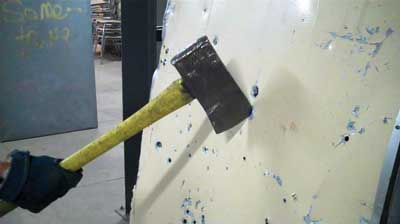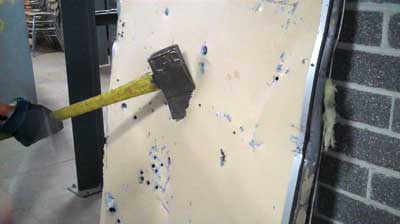By Michael N. Ciampo
Every day, firefighters encounter new and improved locking devices or renovated and “beefed-up” homegrown security devices on doors. This is common in the rear of a taxpayer, strip mall, or commercial occupancy with outward-opening doors. In many instances, after realizing the irons (halligan and ax) aren’t working effectively, firefighters will revert to using a power saw to cut the locking device, the carriage bolt heads holding the drop bar’s support bracket, or the door’s hinges to force entry into the structure. Power saws have proven their usefulness over the years in making our job easier and reducing our overall exertion levels. However, they have also been known to fail or break when you need them-you may pull the cord out of the starting coil mechanism or accidentally flood the saw. And if you or other units on scene don’t have a second saw, what are your options?
As with any forcible entry plan of attack, always size up the door and take note if it is inward or outward opening. (Remember, outward-opening doors have the hinges visible to you on one side of the door and frame.) Always try the doorknob before prying. This is basic forcible entry, which often leads to which way we’ll place the halligan tool into the jamb to force it open. It sounds relatively easy, but are we missing something when sizing up the door for forcible entry?
When we look at doors, we often focus on the locks (size, shape, type, and location) and then the material the door is made of (wood, wood with metal skin, or metal) to determine where and how we’ll begin our operations. But how closely do we look at and understand the structural makeup of the door? Do we know if the door is a thin-skinned hollow-core door that will crumble and cave in if we give it a few shots with a tool?
Doors around the country differ in construction; many of the metal door inner and outer skins are about 3⁄16 inch thick. The inside of the door is filled with corrugated cardboard, foam insulation, or polystyrene or is hollow with reinforcement channels running vertically or horizontally. Along the outside perimeter of the door, channels or reinforcing supports or material may exist. On the vertical side, it’s not uncommon to find these materials up to four inches wide; on the top and bottom, horizontal pieces can be up to 12 inches wide. Understanding this allows us to use a saw to cut through both skins and the inner materials in one motion.
CUTTING WITH A SAW
When using a saw to cut both skins of the door, you are normally taught to cut a triangle in the door. Where you cut the triangle depends on what you’re trying to accomplish-whether it is for forcible entry or water stream application. If you’re trying to cut a small triangle through the door to reach in and open a locking device such as a “fox lock” (horizontal door locking bar) or “multilock” (inner rod locking mechanism), cut the hole toward the lock side of the door frame and just below the locking mechanism’s horizontal bar. Then you can use a gloved hand to reach into the space and unlock the device as well as the locks on the frame side of the door. When cutting for hoseline stream application, cut the hole through the upper portion of the door so the stream can enter this space and be directed upward toward the ceiling so its pattern is deflected and dispersed over a larger area.
When cutting a metal door, always start with the saw at slow revolutions per minute and bring it up to full throttle once you make the initial purchase point. Hold the saw with its bumper stops on the door so you can lift the trigger handle and pivot the saw into the door slowly. Of course, if the door is hot with paint peeling and discolored, you may forgo that technique so you don’t damage the rubber saw bumper mounts or saw.
Another technique to start a cut on a metal door is to hit it with the back of the ax and create a dent or purchase area trough for the blade to grab into. This technique works well to cut the heads of the carriage bolts that hold in a drop bar.
Always use caution when using an abrasive disc blade to cut a metal door. When cutting both skins of a hollow or reinforced door, bury the blade at least a few inches into the door to ensure you cut both sides in one application. If the saw and blade are twisted while cutting through both materials, the blade may bind or snap and become a flying projectile. Operate the saw at full throttle and allow the saw to follow a line; rock it slowly if you feel reinforcing bands/channels while cutting through the door. Although newer, all-purpose blades (diamond grit) are less prone to snapping or shearing off, it can happen and has happened. Always use caution when cutting.
Since the skins on these doors are very thin, it may not be necessary to cut all three legs of the triangle to make an opening. Cutting two diagonal lines and then peeling the metal back and downward on the outside skin and punching in and then down on the inner panel may be all you need to create the opening. If the door has insulation or cardboard in between skins, it may have to be removed prior to punching in the inner skin; or, cut the third leg of the triangle and remove the material. Always use full personal protective equipment if you’re sticking your arm into this space, to reduce being cut or burned if fire or heat should vent through this opening. Once you open a hole, you can remove a drop bar, unlock a horizontal lock device, or unlock the door locks.
CUTTING WITH THE IRONS
Normally, you would choose a power saw to cut metal skin doors. Unfortunately, power tools can fail because of a malfunction or an operator error. It is important to know all about hand tools in case you have to revert to using them. The irons have been used for a multitude of tasks in forcible entry operations; it is important to understand all you can accomplish with them. If a power saw fails, you can still perform the cutting operation with hand tools.
The first step is to drive the point of the halligan tool through both skins of the door. Then take the point out of the hole you created without widening the hole; you’re trying to prevent the skin from rolling over on itself and being more difficult to cut. Once you have removed the halligan’s point, put the top section of the ax blade in the hole (photo 1). Only use the very top portion of the blade; don’t try to bury it through both skins. You’re only trying to cut the outside skin in the first cut. Cutting both skins at once is very difficult and causes the ax to bind in the door more. Normally, you would cut a triangle, but using hand tools makes cutting the bottom horizontal cut a little more difficult and time-consuming, and the door construction doesn’t require it. Your pattern will be to cut the two downward diagonal lines of a triangle and, if needed, switch them to downward vertical cuts.
 |
| (1) Insert only the top third of the ax into the purchase hole. (Photos 1 and 2 by author.) |
Now that the ax blade is sitting in the hole, strike it with the halligan tool and begin cutting the door. Don’t hit it the first time with a great deal of force; hit it hard enough to gain a purchase in the metal skin. The firefighter holding the ax handle should hold it with both hands at the end of the handle to permit access for the striking firefighter and to be away from the halligan if it should deflect off the ax head. During the cutting process, the firefighter holding the ax handle should lift up on the handle and rock it a little to prevent the whole blade from coming in contact with the door’s skin. Use only the tip of the ax head for an easier cut. If the whole blade comes in contact with or is buried into the skin and insulation, it makes the cutting process more difficult (photo 2). The striking firefighter should focus on the ax head and blade and communicate during the cut if any movements are needed. Cut the first diagonal leg at least 12 inches down from the initial purchase hole. During the second diagonal cut, the firefighters can switch positions so that neither of them becomes fatigued (photo 3).
 |
| (2) The ax blade is buried too deep into the door; this causes additional friction while cutting. |
 |
| (3) While swinging the halligan, keep the pike to the side so it won’t bounce upward toward you. (Photos 3-5 by J.J. Cassetta.) |
After cutting the second leg, insert the halligan adz and pry back the door’s outside skin. As you peel back the material from the door, make a quick strike with the back of the ax head at the bottom of the cuts to make a crease and allow the material to fold down to this point easily. Once you peel back the outside skin, you can remove the insulation or corrugated cardboard with the halligan adz. Then begin cutting on the door’s inside skin. When that is completed, use the back of the ax head to knock in the inner skin and then hit it with downward blows to bend it out of the way. Use caution if you’re using a battering ram motion to knock in the inside skin; too much force can bury the tool head as the inner skin springs back upward.
LESSONS LEARNED AND REINFORCED
- Cutting the door is fairly simple using this method with these two tools. However, if another ax, maul, or striking tool is available, it will make the striking process easier, and you will gain more cutting distance with each blow (photos 4, 5). That is because the tool is heavier than the halligan and when you swing it, it has more momentum and force as it hits the cutting ax. Remember, when swinging, let the ax slide through your hands and pick up speed. Don’t thrust your arms and body into the strike; that wears down your endurance and causes fatigue.
- Using overhead chopping motions with the ax while cutting the metal door is very difficult. The cut line often goes askew and if the ax bounces off the door, it could hit you on the recoil of the swing.
- During training, some firefighters insisted on inserting the halligan’s forks into the space and pulling down on the halligan to cut the skin. It works, but the cut line often goes askew, and it is more difficult than just hitting the ax with the halligan.
- On tougher skin doors, after you cut the diagonal lines, cutting downward vertical lines makes it easier to fold down the material. It also allows easier tool placement inside the pattern to cut the door’s inner skin.
- On lightweight garage doors, this method works well to create an opening to release the door locks. On roll-down security garage doors and gates, this method isn’t the best option. Many of the interconnecting pieces have a small rod between sections that is difficult to cut.
- Keep your hand tools clean and sharp to help make this cutting process easier and safer. Also, remove any burrs on the striking side of the ax so they don’t become flying projectiles.
 |
 |
| (4, 5) Another heavier cutting tool makes the cutting process easier and allows you to cut more with each strike. Let the tool handle slide through your hands for more momentum and less fatigue. |
Power saws and equipment are invaluable to firefighters, but when they fail, you’ll have to revert to hand tools, so you had better know how to push those tools to the limit. Cutting a door with the irons is by no means the primary method, but it can be a backup plan if no other saw is available.
MICHAEL N. CIAMPO is a 28-year veteran of the fire service and a lieutenant in the Fire Department of New York. Previously, he served with the District of Columbia Fire Department. He has a bachelor’s degree in fire science from John Jay College of Criminal Justice in New York City. He is the lead instructor for the FDIC Truck Essentials H.O.T. program. He wrote the Ladder chapter and co-authored the Ventilation chapter for Fire Engineering’s Handbook for Firefighter I and II (Fire Engineering, 2009) and is featured in “Training Minutes” truck company videos on www.FireEngineering.com.
Michael N. Ciampo will present “Truck Work: From Training to Tactics” on Thursday, April 10, 3:30 p.m.-5:15 p.m., at FDIC 2014 in Indianapolis.
Fire Engineering Archives

